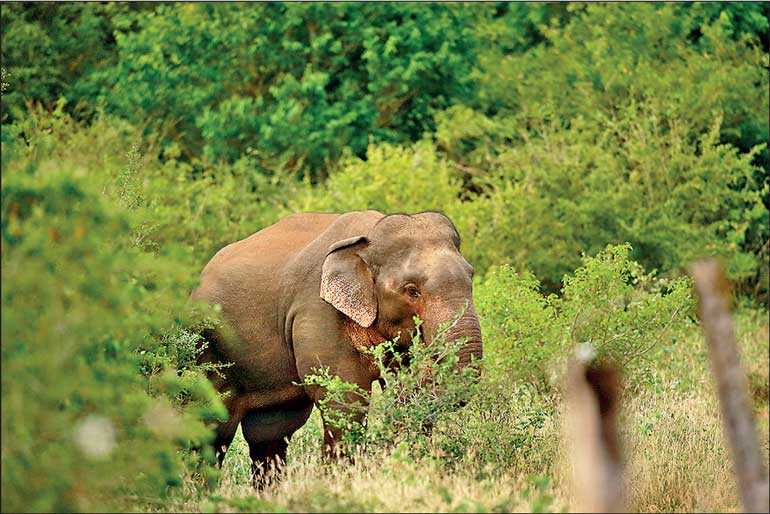Thursday Jan 15, 2026
Thursday Jan 15, 2026
Friday, 31 July 2020 00:00 - - {{hitsCtrl.values.hits}}

Pix by Namal Kamalgoda
 and mitigate HEC:
and mitigate HEC:
There is one main problem with all these strategies – none of them focus on the conservation of the elephants. All are in place to protect the welfare of the humans while sadly that of the elephant has been largely ignored. While both elephants and humans are victims of HEC, all strategies are to help humans whilst there are no strategies put in place to help the elephants.
Furthermore, these strategies make matters even worse for the elephants. They suffer harassment, psychological fear, loss of habitat/resources or access to habitat and feeding grounds, and loss of their natural roaming range. This can only lead to one outcome – their ultimate extinction.
How should we solve the HEC?
In terms of HEC, the DWC has consistently failed with its existing policies. This is not solely their fault. They are victims too, as under the present systems of Government, they have to abide by the whims of whoever has been appointed as their current political master – the Minister for Wildlife. Often with no empathy or understanding of the subject, these representatives of the people do just that – represent people only, and not wildlife. Of the 35 plus ministries and 50 plus departments of the Government, only the Ministry of Wildlife Resources, and its corresponding Department of Wildlife and Conservation, has been appointed with the sole mandate of looking after the welfare of wildlife.
If they, too, concentrate on people, then what hope is there for our precious wild creatures? They are truly left without a voice. As explained in part one of this series, elephants share about 44% of Sri Lanka’s land with humans – 2.8 million hectares – where approximately 10-15 million people live. Conflict, however, does not happen in every area. Those living in ‘purana gamas’ (traditional villages) have learned, over the centuries, to live in harmony with their pachyderm neighbours.
This way of life, however, is coming under increasing stress, too, due to poorly planned development projects, when the traditional movements of elephants have been blocked and they are forced to seek alternative paths, in search of food and water, through villages and cultivations. The conflict is also high when new settlers are moved into areas inhabited by elephants, with no previous experience of living with them, or other wildlife. Sri Lanka needs development, however it should be well-planned development that takes into account the environment and wildlife already living in these areas, while having mitigation plans as an integral part of the project development plans. The Environmental Impact (EIA) process is vital to this, and is currently flawed (more of this in a future article).
Kill or co-exist?
Option one is possible and involves the culling of a couple of thousands of wild elephants. Driving them to new areas will ultimately achieve the same as they would soon run out of food and starve to death. In addition, with just over 6,000 elephants in Sri Lanka, such a drastic reduction in number and the  creation of isolated pockets of animals, will inevitably result in their genetic deterioration and ultimate extinction – not just of elephants, but of all large mammals.
creation of isolated pockets of animals, will inevitably result in their genetic deterioration and ultimate extinction – not just of elephants, but of all large mammals.
Option two will never be entertained by today’s political powers, though it was successfully achieved in the past in the creation of the Uda Walawe National Park.
This leaves co-existence as the only logical, ethical, sustainable, and long-term solution to this problem.
What do the experts say?
There are many strategies which we can implement to enable the peaceful co-existence of elephants. Science and research have shown that they work.
Why we should really care about our elephants?
Apart from the emotions of joy and feelings of wonderment brought on by elephants, do they in fact contribute in any other way to Sri Lanka’s people and its land? The answer to that is a resounding ‘yes’, for the following reasons:
What we must appreciate is the privilege of sharing the same land as these mighty creatures who do so much for our land as well as our economy. Sadly, due to the complete lack of will to address the human elephant conflict on a scientific basis, the Sri Lankan elephant population is declining at a rapid rate – made worse each year by decreasing habitat and feeding grounds.
Conserving these gentle giants is of utmost importance and the time is long overdue for us, the more ‘intelligent’ species, to find better and more sustainable solutions for Sri Lanka’s Human-Elephant Conflict.
(FEO is a non‐political, non-partisan organisation that provides a platform for connecting interest groups with a patriotic interest in safeguarding Sri Lanka’s natural heritage through conservation and advocacy. Visit www.feosrilanka.org for more information.)